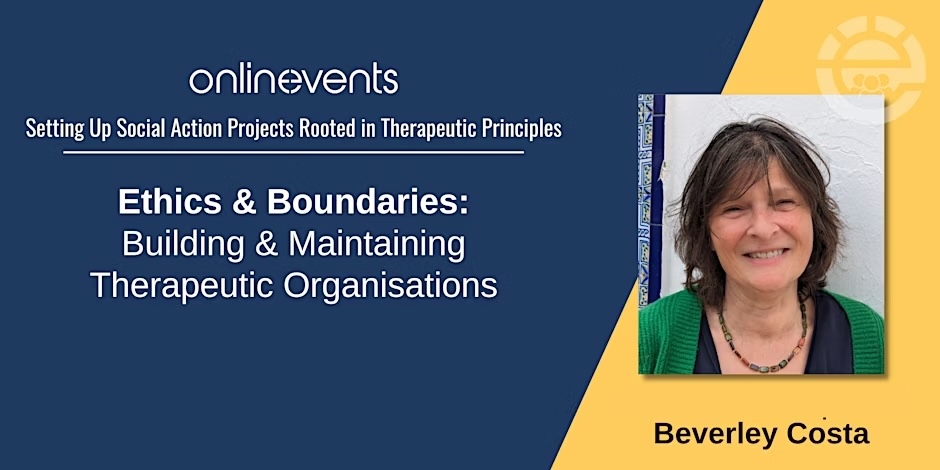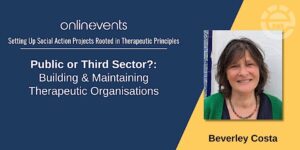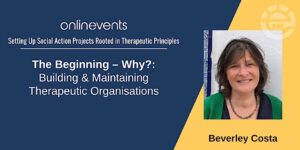Introduction
As an organising principle “being a lovely organisation” works well. Until it doesn’t. An organisation which is set up with the best of intentions can be destroyed when its unconscious motivations are left unexplored. There is nothing wrong with motivation. Without it we wouldn’t get anything done. However, without appropriate ethical guidance, boundaries can be ruptured. This can produce unintended and unwanted consequences. Without exploration and understanding of motivations like guilt, fear and rage that can drive us to set up social action projects, it will probably be difficult for an organisation to develop a truly accountable and reflective culture.
A reflective organisation consciously and continuously assesses its behaviour so that it offers a response rather than a reaction to the issues it faces. To do this safely and productively, organisations work within an ethical framework which is guided by their values and principles.
In this second blog, we discuss how an organisation can implement its values by using an ethical framework and maintaining its professional boundaries consistently in ways that are enabling rather than constraining. Boundaries, applied with thoughtfulness and care, can be containing and respectful of the organisation’s beneficiaries and everyone involved.
Here’s an illustration of the challenge of maintaining ethical boundaries in social action projects.
Imagine that you are the project leader of a counselling and social support service for refugees. Your service has a small pool of interpreters who sometimes interpret for social workers who are supporting asylum seekers. At one of your Reflective Practice Support Group meetings an interpreter explains that she has been interpreting for a social worker and a young unaccompanied asylum seeker. She is very affected by how lonely the boy seems and the desperateness of his situation. He is finding it hard to concentrate in school. She wants to offer him some one-to one informal English practice to help him to integrate into school. Having had training with the project she wants to check that this is acceptable and will not be a breach of the project’s boundaries and framework.
The group agrees that having some English sessions with a person he already knows and trusts and who is from his country could be a very good thing as he is far from home and from a sense of familiarity and safety.
You are concerned, though about a number of things.
- You don’t think it would be appropriate for the interpreter to interpret for the boy and give him one-to one informal sessions too. You are informed by ethical considerations about managing dual relationships which can be found in The BACP Ethical Framework (2018) https://www.bacp.co.uk/events-and-resources/ethics-and-standards/ethical-framework-for-the-counselling-professions/
- You think that the offer is motivated by compassion but there is a risk that it could have a detrimental effect.
- You are concerned about protecting the child and managing his expectations. He might, for example, experience the offer of the one-to one sessions as an act of intimacy which was not the interpreter’s intention.
- You wish to protect the interpreter appropriately from misunderstandings. The interpreter could find herself in an awkward situation. As a result, she might want to stop working with the boy, which might leave him further isolated.
- You are concerned about fairness. An offer to an individual may benefit them but are other beneficiaries of the service able to access similar offers?
- You absolutely do not want the compassionate intention to be lost.
- You want to think with the group about possible appropriate and compassionate responses.
You share your concerns with the group. One member of the group says of the interpreter “But she was only being human after all”. You agree that this offer is motivated by compassion and humanity and you thank the interpreter for having the courage to bring the dilemma to the group. You say, “Maybe we could come up with an alternative approach.”
You think together and come up with the following: your project could offer the social work team the possibility of some of your interpreters being present in their clients’ first three English classes, with the agreement of the English teacher. The interpreter would not be alone with the client and there would be an understanding that there would be a limit to the number of times this would happen. The interpreter could translate for the client, when necessary, so they could avoid getting completely lost. In this way, an act of compassion could take place, but without potentially giving the boy expectations about the relationship with the interpreter which could lead to profound disappointment. The initiative would be framed with a shared understanding of the limits and possibilities. It might also develop into a mini-project where other children, who spoke different languages, could also benefit.
This may seem like a very small example but it illustrates the way in which a reflective organisation can explore unexamined good intentions and their potential impact, use ethical guidelines and find intentional and compassionate responses. It is also an example of the “No but Yes” approach[1].
It can be difficult to challenge someone who says “I was only being human”. It is a phrase that may justify behaviour and actions. Of course, engaging with our humanity is crucial in social justice work. But the phrase rationalises a reaction. It does not invite exploration and reflection. The phrase is often used to challenge policies and procedures. Sometimes policies need to be challenged but that is frequently more productive when it is done reflectively in dialogue and open discussion.
A project needs policies and procedures, rooted in its values and the ethical framework to which it subscribes. Policies offer protection to everyone involved and they support the sustainability of the project. But a rigid reliance on the policies without reflection and consideration inhibits dynamism and creativity. Social action requires agility in order to respond to rapidly changing social circumstances. The policies and procedures of a project are a starting point. Their functionality is improved when they are used in conjunction with reflective and continuous assessment of their effectiveness.
If the culture of an organisation is one of trust and support, interdependence and respect for collective wisdom, then open conversations about wanting to push the boundaries are welcomed and not judged. Collective wisdom, like clinical wisdom is pragmatic, balanced and paradoxical: “…it is built upon kindness, humility, and a deep regard for the Other.” (Baum-Baicker & Sisti, 2012:13). Reflective conversations can lead to creative thinking about ethical responses rather than reactions in the moment.
Do we need a new ethical framework? – an extension for social action practice
Ethical frameworks provide guidance around our behaviour to protect people who have less power than others. Boundaries provide limits and fairness by keeping people safe, protecting people from burnout and protecting beneficiaries from other people’s egos.
Beneficence is the obligation to act for the benefit of another and to protect and prevent harm. Autonomy is the freedom to make your own decisions and to be in control of your own life. The BACP Ethical Framework (2018) https://www.bacp.co.uk/events-and-resources/ethics-and-standards/ethical-framework-for-the-counselling-professions/enshrines respect for client autonomy. A response based on beneficence is ethically entirely appropriate in an emergency or a life threatening situation. In a social action project an essential ethical task involves assessing the level of threat involved in the situations that we are asked to help with.
When we are working with the most vulnerable people in our society, the pull to help can appeal very strongly to the part of us that wants to protect and save people from pain. What can be done within our professional frameworks and how do we take social action grounded in our ethical principles?
The line between empowering people to find their own solutions and solving their problems for them, can be very thin. So how do we find a way to take action that is empowering and ethically anchored? If our current psychotherapy and counselling ethical frameworks were not designed with social action projects in mind we may need an additional set of ethical guidelines to support us when we extend our work beyond the walls of the consulting room.
How do social action projects conduct themselves with ethical maturity (Carroll & Shaw, 2013)? The three main ethical challenges in psychotherapy relate to trust, caring and power. They may also be the three challenges in social action projects. There are also others.
Here are some examples of ethical tensions in social action projects not covered by many current ethical guidelines:
- The balance between care for workers and the care for clients – who are the ultimate beneficiaries?
- Working with people whose social contexts (their outer worlds) seem hopeless. How do we deal with our sense of inadequacy in the light of current social injustices? How do we respond ethically to the desire “to be human” in the face of insufficient support systems?
- How do we take social action and remain accountable?
- What is the ethical responsibility of a social action project to form an organisational culture which results in compassion satisfaction rather than compassion fatigue?
- How are resources and their management an ethical issue? Saying Yes is sometimes easier than saying No, but is it fair? What is the ethical approach to resource distribution and management? How do you make the resources work in the fairest way possible for the maximum number of people?
- What is the project’s ethical responsibility in terms of funding? Is it alright for a project to raise some funds and to allow the funds to run out without having a strategy of sustainable funding which is actioned, well before the money comes to an end?
The family therapist John Byng-Hall referred to the consequences of family roles being upended as “ironic” (2008). The consequences of upended and ruptured boundaries in social action projects can also be ironic. They include:
- A project gets in the way and ironically make things more difficult for a beneficiary to access adequate information and support.
- Actions are taken based on subjective views, beliefs, needs – whether someone or something is deemed worthy.
- A project tries to Rescue, becomes perceived as the Persecutor and feels like the Victim in the Drama Triangle (Karpman, 1986).
- Immediate and individual needs are addressed but potentially to the detriment of the collective/community.
- Every problem is treated like a crisis.
- The project loses a sense of accountability
- Fairness and equity may be impacted negatively.
Social justice initiatives are founded on care and compassion. But social justice is also complex. A social action project needs a frame which can contain its complexity and nurture its creativity. A frame needs attention. It has to be tended or it will collapse.
Ironically, good intentions, no matter how lovely, are not reliable organising principles for social action projects. They do not automatically lead to their intended consequences. Unexamined good intentions can create more than ironic consequences. They can be unsustainable. They can even cause harm.
A social action project which is committed to a reflective culture works within a frame where there is space and time to think continuously and collectively about its policies, the ethical dilemmas it encounters and its professional boundaries. As organising principles, collective reflexivity and accountability are more likely to lead a project to consequences for its beneficiaries that are the intended outcomes.
References
Baum-Baicker, C. and Sisti, D. (2012). Clinical wisdom in psychoanalysis and psychodynamic psychotherapy: A philosophical and qualitative analysis. The Journal of Clinical Ethics, Spring 2012, 23 (1), 13-27.
Byng-Hall, J. (2008). The significance of children fulfilling parental roles:
implications for family therapy. Journal of Family Therapy, 30: 147
162. https://doi.org/10.1111/j.1467-6427.2008.00423.x
Carroll, M., and E. Shaw. (2013). Ethical maturity in the helping professions : making difficult life and work decisions. London: Jessica Kingsley Publishers.
Karpman, S. (1986). Fairy tales and script drama analysis. Transactional Analysis Bulletin 7(26): 39-43.
[1] The “No but Yes” approach
What happens to the people you can’t help at all if you choose to use your resources to help a few people? Is it an intentional choice in line with the values of your project? How does your project regard equality and equity?
The “No but Yes” approach is one way of enacting an intentional choice about the use of resources. It was exemplified in the earlier illustration. The underlying ethical and relational principle of the approach involves recognising the limits and holding the line. That’s the “No”. However, it doesn’t stop there. An alternative proposal in response to a request that does not overstep the limit can often be found. That’s the “Yes”. The relational element of the approach comes alive when the alternative offering is offered with empathy and care, and whenever possible it includes those involved in thinking together about how resources can be shared. On the BACP website you can find a free resource about using the Social Response Cycle to set up social action projects. On this page you can find a 2-minute film called Case Exercise: Ethical Considerations: https://www.bacp.co.uk/cpd/social-response-cycle-member-resource/src-section-4/ it gives an example of the “No but Yes” Approach.





